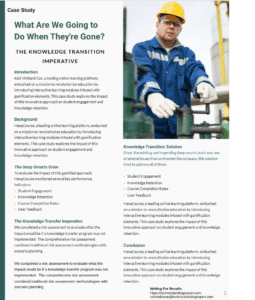Knowledge Transition
What Are We Going to Do When They’re Gone?
Knowledge Transition Imperative
Knowledge transition encompasses both explicit knowledge (documented in manuals and databases) and implicit knowledge (gained through experience and intuition)
Retirement without knowledge transfer is one of the most anticipated–and unwelcome–impacts of the silver tsunami. The knowledge void left by the exodus of retirees can affect a company everywhere from its ability to attract new employees to its bottom line.
Knowledge transition, or knowledge transfer, is a relatively new field. As baby boomers approach retirement, this field has gained particular significance in addressing the critical challenge of retaining institutional knowledge.
Knowledge transfer encompasses systematic strategies for capturing, storing, and sharing expertise from key personnel to others within organizations.
Organizations that successfully implement knowledge transfer strategies will be better positioned to maintain operational continuity and competitive advantage.
The field continues to evolve with emerging technologies and methodologies focused on preserving institutional knowledge while facilitating cross-generational learning.
But, one thing is clear: Knowledge transition in any company is an imperative, a vital element of business continuity.
Knowledge Transition Services
This download is a non-inclusive listing of the knowledge transition services that we provide. We offer both standalone knowledge transition standard operating procedures that contain comprehensive descriptions, checklists, information from current employees, images, and business continuity information. Each one is structured for continuous update and review.
We also offer knowledge management plans that integrate as many of your business entities as you wish to include.
Knowledge Transfer Services Download
Squandering Deep Smarts
When a person sizes up a complex situation and rapidly comes to a decision that proves to be not just good but brilliant, you think, “That was smart.” After you watch him do this a few times, you realize you’re in the presence of something special. It’s not raw brainpower, though that helps. It’s not emotional intelligence, either, though that, too, is often involved. It’s deep smarts.

Because deep smarts are experienced based and often context specific, they can’t be produced overnight or readily imported into an organization. It takes years for an individual to develop them–and no time at all for an organization to lose them when a valued veteran walks out the door. Companies have to be willing to dedicate time and effort to knowledge transitions, but the investment more than pays for itself.
The Financial Cost of Deep Smart Loss
Recent studies show varying estimates of the costs associated with inefficient knowledge sharing in 2024. According to Forrester research, poorly managed knowledge can lead to productivity losses of up to 35%. The most frequently cited figure from 2018 of $47 million in annual losses for large businesses is likely higher now due to inflation and increased remote work challenges. Recent data from 2024 indicates that Fortune 500 companies lose at least $31.5 billion collectively per year from failing to share knowledge effectively. For individual businesses, the cost varies significantly by size – companies with 1,000 employees lose approximately $2.7 million annually, while organizations with 100,000 employees can lose up to $265 million per year. Small businesses are not immune, with organizations of just 10 employees potentially losing $50,000 yearly due to knowledge sharing inefficiencies (Unlocking Hidden Costs Of Ignoring Knowledge Sharing In Business)
Knowledge Transition Case Study
This case study details our development of a knowledge transition plan for an oil and gas production company. Over a period of 10 years, they expected fully 30% of their workforce to retire. Employees spanned a wide range of functions–from engineering to IT to production and maintenance. While this knowledge transition plan did not involve digitization of the information, it was nonetheless comprehensive. As with most of our knowledge transition plans, this included business continuity considerations. Business continuity was built into the standard operating procedures we created for each position.
Case Study Download

Organizational Knowledge
Explicit Knowledge
Characteristics
- Easy to document, articulate, and share through formal means
- Objective, logical, and technical in nature
- Can be stored in physical or digital formats
- Readily transferable through writing, documents, or digital means
Examples
- Standard operating procedures
- User manuals and FAQs
- Company policies
- Technical documentation
- Training materials
Tacit Knowledge
Characteristics
- Difficult to articulate or extract
- Based on personal experience and expertise
- Context-specific and highly personal
- Requires close interaction for transfer
- Gained through practical experience and observation
Examples
- Problem-solving abilities
- Customer service intuition
- Technical expertise and know-how
- Leadership instincts
- Decision-making skills
Knowledge Transition Solutions
A comprehensive approach to knowledge transfer not only helps preserve critical operational expertise but also creates an attractive environment for new talent, as it demonstrates a clear path for professional growth and development within the organization.
Strategic Planning
- Identify critical knowledge holders and essential information to be transferred
- Create structured timelines for knowledge capture before retirement
- Develop clear metrics and incentives for knowledge sharing
Structured Documentation
- Create standardized templates for process documentation
- Develop comprehensive workflow guides
- Establish digital knowledge bases with searchable content
Interactive Learning
- Implement mentorship and shadowing programs
- Create communities of practice for knowledge sharing
- Organize cross-generational projects and collaboration sessions
Retention Strategies
- Flexible Arrangements
- Offer phased retirement programs
- Create knowledge advisor roles for retiring experts
- Establish alumni networks for continued access to expertise
Cultural Integration
- Foster a knowledge-sharing culture through recognition programs
- Implement team incentives for successful knowledge transfer
- Create collaborative environments that encourage cross-functional learning
Success Metrics
- Track knowledge transfer completion rates
- Monitor successor readiness and competency development
- Measure retention of critical institutional knowledge
Your Knowledge Transition Imperative
Contact Us About Our Knowledge Transfer Services–Including Development of Knowledge Transfer Plans
